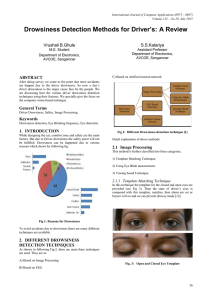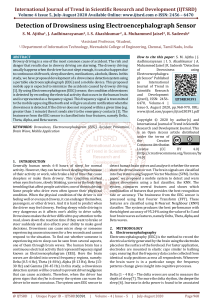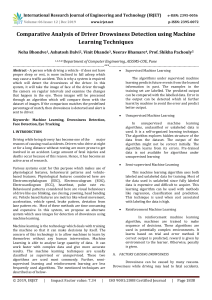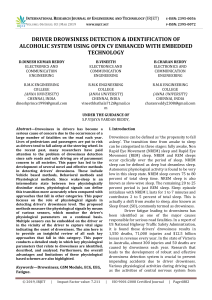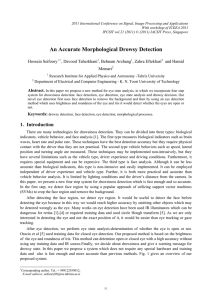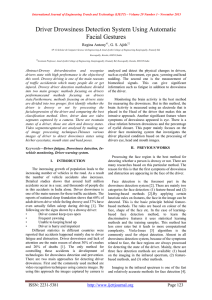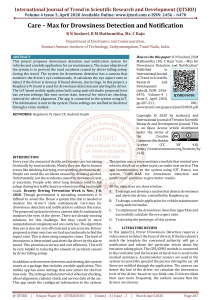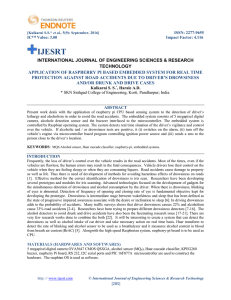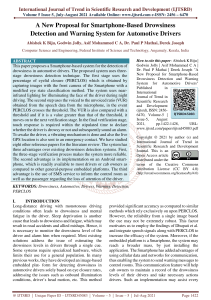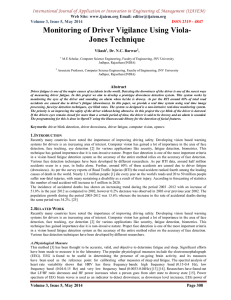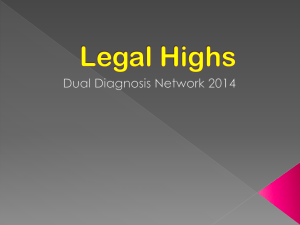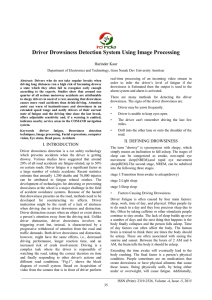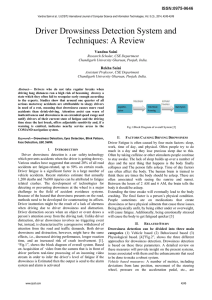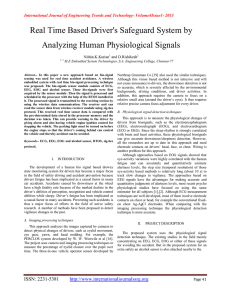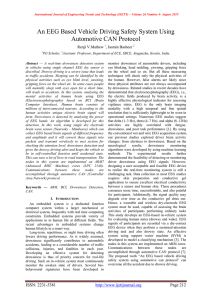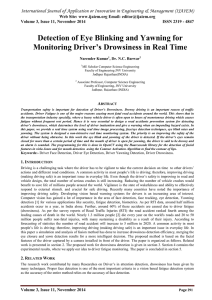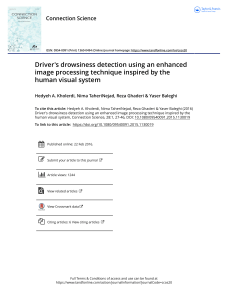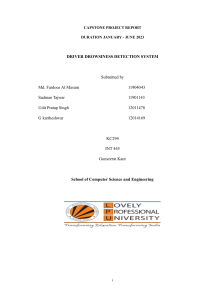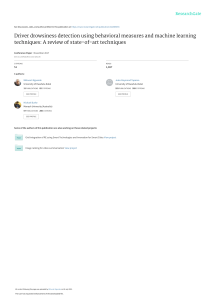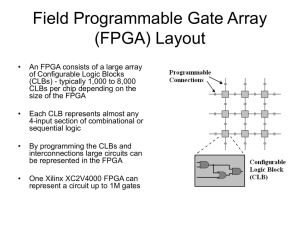A Real-time Non-intrusive FPGA-based - Ann Gordon-Ross
advertisement
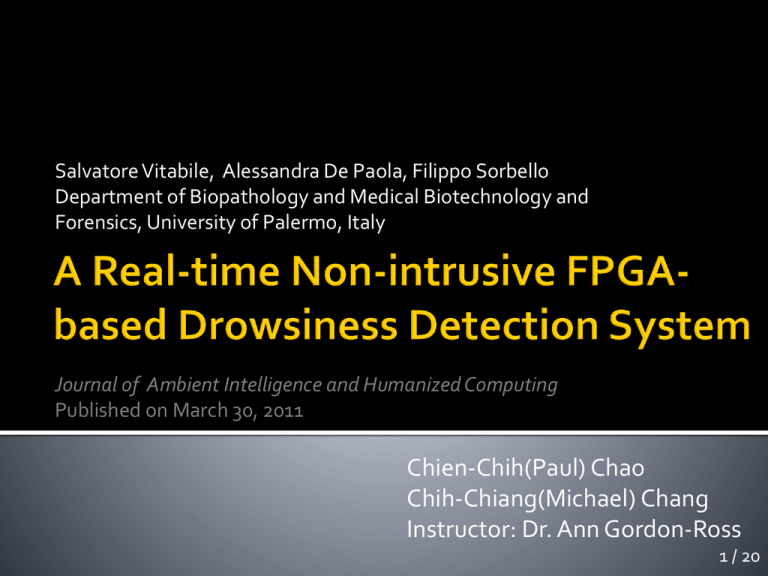
Salvatore Vitabile, Alessandra De Paola, Filippo Sorbello Department of Biopathology and Medical Biotechnology and Forensics, University of Palermo, Italy Journal of Ambient Intelligence and Humanized Computing Published on March 30, 2011 Chien-Chih(Paul) Chao Chih-Chiang(Michael) Chang Instructor: Dr. Ann Gordon-Ross 1 / 20 An embedded monitoring system to detect symptoms of driver’s drowsiness. 2 / 20 Motivation Related works Drowsiness Monitoring System Eye Regions Segmentation Candidate Eye Regions Selection Driver’s Eyes Detection Drowsiness Level Computation Experimental trials Conclusion Limitations & Future Work 3 / 20 10-20% of all European traffic accidents are due to the diminished level of attention caused by fatigue. In the trucking industry about 60% of vehicular accidents are related to driver hypo-vigilance. [1] Automotive has gained several benefit from the Ambient Intelligent researches involving the development of sensors and hardware devices [1] Awake Consortium (IST 2000-28062), System for effective assessment of driver vigilance and warning according to traffic risk estimation (AWAKE), Sep 2001–2004 [Online], available: http://www.awake-eu.org 4 / 20 The technique categories for preventing driver’s drowsiness [2] Readiness-to-perform and fitness-for-duty technologies Mathematical models of dynamics alertness Vehicle-based performance technologies ▪ The lateral position ▪ Steering wheel movements ▪ time-to-line crossing Real-time technologies for monitoring driver’s status ▪ Intrusive monitoring systems ▪ Non-intrusive monitoring systems [2] Hartley L, HorberryT, Mabbott N, Krueger G (2000) Review of fatigue detection and prediction technologies. National Road Transport Commission report 642(54469) 5 / 20 The most accurate techniques are based on physiological measures Brain waves Heart rate Pulse rate Causing annoyance due to require electrodes to be attached to the drivers 6 / 20 A non-intrusive, real-time drowsiness detection system. Using FPGA instead of ASIC of DSP Re-programmability Performance Costs IR camera Low light conditions ‘‘Bright pupil’’ phenomenon to detect the eyes 7 / 20 PERCLOS (Percentage of Eye Closure) The driver eyes are closed more than 80% within a specified time interval is defined as drowsiness. [3] [3] W. W. Wierwille: Historical perspective on slow eyelid closure: Whence PERCLOS?, In Technical Proceedings Ocular Measures of Driver Alertness Conference, Federal Highway Admin., Office Motor Carrier Highway Safety, R. J. Carroll Ed. Washington, D.C., FHWA Tech. Rep. No. MC-99-136, 1999 8 / 20 “Bright Pupil” Threshold Operation Clipping & Morphological Operation 9 / 20 A list of blobs Possible Eye Pairs Quasi-circular shape: Square Bounding Box R R=½a a 10 / 20 11 / 20 Coordinate At t Class Weight Frame 1 Frame 2 Frame 3 Frame 4 [ (X1, Y1) , (X2, Y2) ] [ (X1, Y1) , (X2, Y2) ] [ (X1, Y1) , (X2, Y2) ] [ (X1, Y1) , (X2, Y2) ] t=4 5 t=3 t=2 t=1 Class 21 Class 1 Class 1 Class 1 Class 1 Class 2 Class 3 Class 4 Class 5 34 10 0 0 0 12 / 20 PERCLOS 18 consecutive frames w/o eyes (300 ms) The alarm system is activated! 13 / 20 JSP DF-402 infrared-sensitive camera Color camera in daytime Infrared camera under low light cond. http://www.es.ele.tue.nl/education/oo2/fpga/board.php 14 / 20 Celoxica RC203E XilinX XC2V3000-4 Virtex II FPGA Handel-C ▪ PixelStreams Library http://www.es.ele.tue.nl/education/oo2/fpga/board.php 15 / 20 In light controlled environment Drive-Camera relative distance ID =1 Not affected by driver-camera relative distance 16 / 20 Vertical and Horizontal of head movement ID =2 17 / 20 Real operation condition (External illumination not controlled) ID =3 18 / 20 An algorithm to detect and track the driver’s eyes has been developed by exploiting bright pupils phenomenon Good performance on rapid movements of driver’s head. Performance not affected by driver-camera relative distance. The drowsiness monitoring system can be used with low light conditions by using infrared camera 19 / 20 Faulty operations the driver is wearing glasses the driver’s IR-reflecting objects such as earring Drowsiness usually happen during the evening/night hours Light poles might be recognized as eye candidates due to the shape and size on screen 20 / 20


